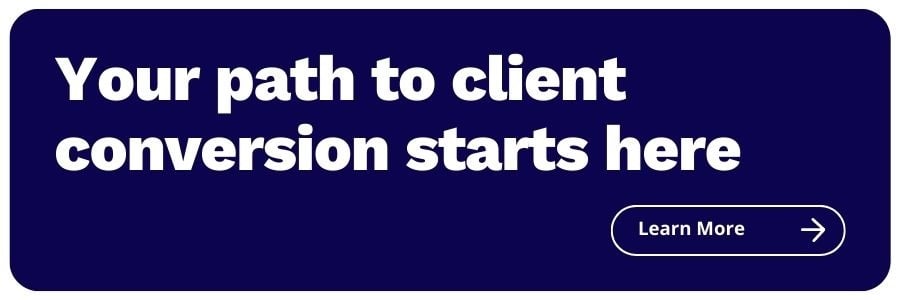How to Build a Sales Pipeline for Your Financial Planning Firm
Share this
You know those words that make you cringe every time you hear them? For many firm owners, “sales” is one of those words.
But sales shouldn’t be cringeworthy. After all, it’s simply about understanding your prospects, cultivating relationships with them, and guiding them through the buyer’s journey.
That doesn’t sound so bad, does it?
Like most other independent financial advisors, you probably got into this line of work because of your strong desire to help people. That’s exactly what you’re doing when you create a sales process and corresponding sales pipeline—you're helping your prospects make a very important buying decision.
With that, let’s dive into how to build out and incorporate a sales pipeline into your financial planning practice.
First, what is a sales pipeline? Simply put, a sales pipeline provides you with a visual representation of the stages a prospect moves through as they progress from a lead to a client.
It allows you to easily keep track of prospects as they move through your sales process from one interaction to the next and gives you a high-level understanding of who is in your pipeline at all times.
A sales pipeline also gives you an idea of how many clients you expect to bring on over any given period of time. From there, you have a solid estimate of the projected revenue your firm will generate over that same time period.
Ideally, your sales pipeline will live within your CRM; if you don’t have a CRM, an Excel file will work. There are free templates you can use, but sometimes, building your own pipeline from scratch is easier because you can cater it to your unique business model.
Building Your Pipeline
Now that you know what a sales pipeline is, let’s explore how to create one. It’s simpler than you might think.
To get started, grab a piece of paper and map out your basic sales activities. Document the different stages someone must move through to become a client, beginning with the initial contact when they request a meeting and ending with the “close” when you onboard your prospect as a client.
The end goal is to have a visual representation that shows all stages of your sales cycle. Below is a basic example of how this may look:
Stage 1: Initial Contact. A prospect express interest in your services and officially enters your sales pipeline. They have requested an initial meeting or call to explore working together further. From here, the prospect will either be ready to progress forward on their own or will need to be nurtured until they are ready to take the next step.
Stage 2: Initial Prospect Meeting Scheduled. You schedule an initial meeting with the prospect to learn more about their goals, their reason for reaching out to, and if they are a good fit for your firm or not.
Stage 3: Initial Prospect Meeting Completed. Your prospect attended your initial meeting. You gathered any required information, discussed the next steps moving forward, and communicated how you can help the prospect solve their problem.
Stage 4: Financial Planning Agreement Sent. In this hypothetical sales pipeline, you and your prospect have agreed to move forward. Your next step is to send over a financial planning agreement for the prospect to sign.
Stage 5: Financial Planning Agreement Signed. The prospect has signed your agreement and is ready to be onboarded as a client of your firm.
Stage 6: Prospect Onboarded as Client. The prospect is officially onboarded as a client—congrats!
This is just a basic example; your sales pipeline may be shorter or longer based on how a prospect moves through the buyer’s journey. There is no right or wrong answer here, and, much like snowflakes, no two sales pipelines will look the same.
The other thing to note is that a prospect may spend a considerable amount of time in certain phases. As you implement and monitor your pipeline, you will gain a better understanding of how long each phase takes, on average, and will know with relative certainty the likelihood of any given prospect converting to a client.
Never Stop Refining
Your sales pipeline won’t be static once it has been created and implemented; you will continue to refine it over time. The sales pipeline you first create may be very different than the sales pipeline you use a year down the road. Don’t be afraid to make changes as needed.
Also, be sure your pipeline is always growing. Without new leads, you will have no new prospects, and in turn, no new clients. That’s not a good place to be. You should consistently be bringing leads into your pipeline.
Need some lead generation ideas? Ask current clients for referrals, create a free, gated download you can place on your website, and/or engage on social media. Don’t be afraid to think outside the box too. Find community events in your area where you can give a presentation on a topic, and send around an email sign-up sheet. Leads are out there—you just have to find them (or rather put in the legwork so they can easily find you).
You can also use your sales pipeline to help build out your lead nurturing campaigns. As you begin to move prospects through your pipeline, you will have a better understanding of what key activities guide a prospect from one stage of the pipeline to the next.
Maybe sending a follow-up email to a prospect if their financial planning agreement hasn’t been signed within 24 hours of receiving it encourages them to sign it quicker. Or maybe calling a prospect within two hours of their initial contact gets them on the calendar sooner. Always be gathering data and, more importantly, learning from it.
Make a list of different marketing activities you need to focus on to get the information into the hands of your prospects so they remain interested in what you have to offer. It's helpful to keep a current list of relevant blogs, podcasts, and articles you can use to re-engage prospects if they go quiet—simply shoot them a short and sweet email sharing a helpful resource.
Keep It Organized
Your sales pipeline will only work to its full potential if you keep it up to date. Scrub the data in your pipeline periodically to ensure it’s accurate and your prospects are in the correct stages. It's okay to remove any leads who are stagnant. For example, if you have followed up with a lead multiple times offering an initial meeting, but they still haven’t budged, or a prospect has blown off an initial meeting multiple times, remove them from your pipeline.
Don’t lose track of them though! Keep a list of these “dead” leads in your CRM and consider circling back down the road. Just because someone isn’t quite ready to move forward with a purchase now doesn’t mean they won’t ever be. (Although there will be people you know aren't, and never will be, a good fit for your firm—these are unqualified leads, and you shouldn't waste your time on them.)
Don’t worry about getting your pipeline perfect or 100% right the first time (you most likely won’t). It will take at least a few months and quite possibly a few iterations to figure out what works for your firm and what doesn’t.
You may determine some stages no longer make sense or maybe you need to add a stage you initially overlooked. And, as your business evolves, some stages may change completely. That’s okay—your sales pipeline is meant to be dynamic, not static. What you’re really after is a sales pipeline that offers a real-time, big picture perspective of your prospects.
 About the Author
About the Author
Lindsey White is known as the Network Navigator at XYPN, helping prospective members learn more about membership and what it takes to join our growing community. She is passionate about sharing the tools and resources the community has to offer to help individuals start, run, and grow their own fee-only financial planning practices.
Share this
- Fee-only advisor (381)
- Advice (305)
- Business Development (248)
- Independent Financial Advisor (203)
- Growing Your Firm (161)
- Marketing (133)
- Financial Planning (129)
- What Would Arlene Say (WWAS) (81)
- Business Coach (80)
- Firm Ownership (78)
- Training (75)
- Compliance (72)
- Business (69)
- Building Your Firm (65)
- Financial Advisors (63)
- Online Marketing (61)
- Events (59)
- Starting a Firm (52)
- Staffing & HR (49)
- Technology (49)
- From XYPN Members (48)
- Launching a firm (46)
- Advisors (41)
- Entrepreneurship (38)
- Taxes (37)
- Networking & Community (33)
- Interviews and Case Studies (32)
- Investment Management (31)
- Sales (27)
- Social Responsibility (27)
- Tax Preparation (27)
- XYPN Invest (26)
- Business Owner (25)
- Small Business Owner (20)
- Financial Management & Investment (19)
- Industry Trends & Insights (19)
- Financial Education (17)
- Financial Planners (17)
- Independent Financial Planner (17)
- Tech Stack (17)
- XYPN (17)
- Leadership & Vision (16)
- Investing (15)
- Niche (15)
- How to be a Financial Advisor (14)
- NextGen (14)
- RIA (14)
- Media (13)
- Preparing to Launch (13)
- Press Mentions (13)
- RIA Operations (12)
- RIA Owner (12)
- XYPN Membership (12)
- Assets Under Management (AUM) (11)
- First Year (11)
- Goals (11)
- Scaling (10)
- Advisor Success (9)
- Building Your Firm (8)
- Communication (8)
- Lessons (8)
- Study Group (8)
- Time Management (8)
- Virtual Advisor (8)
- Behavioral Finance (7)
- Growth (7)
- Pricing Models (7)
- From Our Advisors (6)
- Independent RIA (6)
- Money Management (6)
- Motivation (6)
- Processes (6)
- Automation (5)
- Broker-Dealers (5)
- College Planning (5)
- Filing Status (5)
- How I Did It series (5)
- Investment Planner (5)
- Mental Health (5)
- Michael Kitces (5)
- Preparing to Launch (5)
- RIA Operations (5)
- Retirement (5)
- Risk and Investing (5)
- S Corpration (5)
- Support System (5)
- TAMP (5)
- Wealth (5)
- Year-End (5)
- Client Services (4)
- Outsourcing (4)
- Selling a Firm (4)
- Succession Plans (4)
- Benchmarking Study (3)
- Budgeting (3)
- Career Changers (3)
- Engagement (3)
- Fiduciary (3)
- Getting Leads (3)
- Membership (3)
- Millennials (3)
- Monthly Retainer Model (3)
- Partnership (3)
- Pricing (3)
- Recordkeeping (3)
- Risk Assessment (3)
- Small Business (3)
- Staying Relevant (3)
- Work Life Balance (3)
- Advice-Only Planning (2)
- Bookkeeping (2)
- Charitable Donations (2)
- Client Acquisition (2)
- Differentiation (2)
- Health Care (2)
- IRA (2)
- Inflation (2)
- Productivity (2)
- Implementing (1)
Subscribe by email
You May Also Like
These Related Stories

Why You Need to Align Your Firm's Marketing and Sales Strategies





